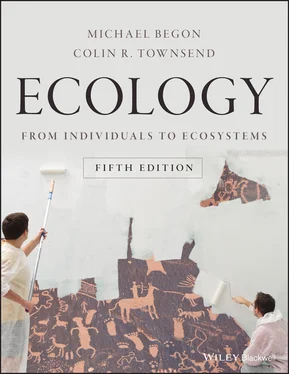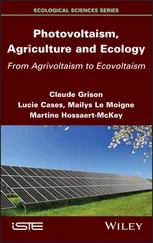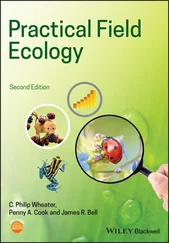Source : From data in Devine & Harrington (2011).
density: a convenient expression of crowding
Thus, whether mobile or sessile, different individuals meet or suffer from different numbers of competitors. Density, especially resource‐weighted density, is an abstraction that applies to the population as a whole but need not apply to any of the individuals within it. Nonetheless, density may often be the most convenient way of expressing the degree to which individuals are crowded – and it is certainly the way it has usually been expressed.
5.3 Quantifying intraspecific competition
We have seen that there are general patterns in the action of intraspecific competition, and now we quantify these general patterns more exactly, utilising k values (see Chapter 4) to summarise the effects of intraspecific competition on mortality, and then extending this to fecundity and growth.
use of k values
A k value was defined by the formula:
(5.4) 
or, equivalently:
(5.5) 
For present purposes, ‘initial density’ may be denoted by B , standing for ‘numbers before the action of intraspecific competition’, while ‘final density’ may be denoted by A , standing for ‘numbers after the action of intraspecific competition’. Thus:
(5.6) 
Note that k increases as mortality rate increases.
plots of k against log density
Some examples of the effects of intraspecific competition on mortality are shown in Figure 5.11, in which k is plotted against log B . In Figure 5.11a and b, k is constant at the lowest densities. This is an indication of density independence: the proportion surviving is not correlated with initial density. At higher densities, k increases with initial density; this indicates density dependence. The way in which k varies with the logarithm of density indicates the precise nature of the density dependence. Thus, Figure 5.11a and b describe, respectively, situations in which there is under‐ and exact compensation at higher densities. The exact compensation in Figure 5.11b is indicated by the slope of the curve (denoted by b ) taking a constant value of 1 (the mathematically inclined will see that this follows from the fact that with exact compensation, A is constant). The undercompensation that preceded this at lower densities, and which is seen in Figure 5.11a even at higher densities, is reflected in b being less than 1. Of course, b does not always vary over the observed range of densities. Figure 5.11c is an example in which density‐dependence is undercompensating throughout the range, whereas in Figure 5.11d the mortality shows overcompensation ( b > 1) throughout the range.
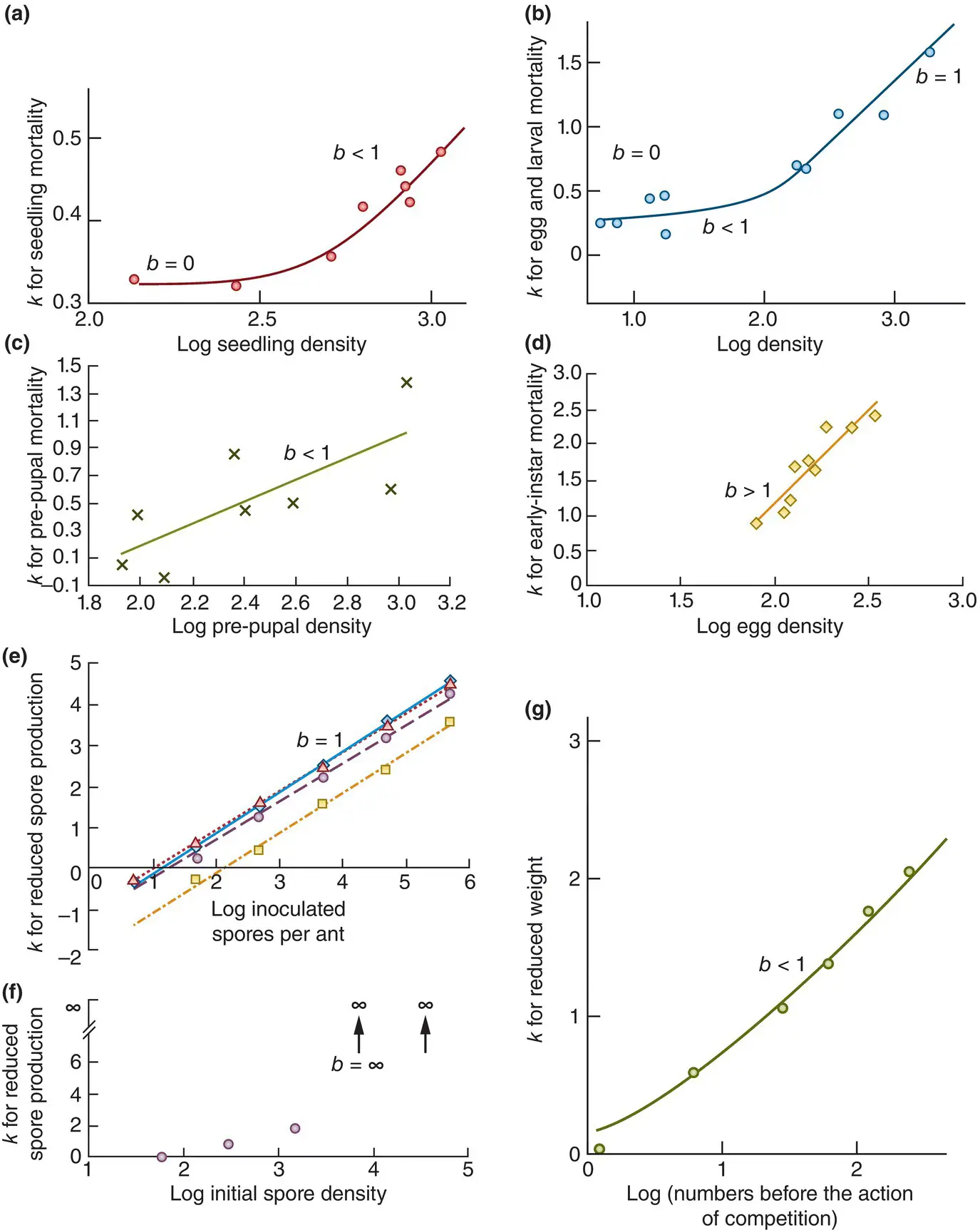
Figure 5.11 The use of k values for describing patterns of density‐dependent mortality, fecundity and growth.(a) Seedling mortality in the dune annual, Androsace septentrionalis , in Poland. (b) Egg mortality and larval competition in the almond moth, Ephestia cautella . (c) Pre‐pupal mortality in the Argentine stem weevil, Listronotus bonariensis , in New Zealand. (d) Early instar mortality in the European corn borer, Ostrinia nubilalis , in New York state. (e) The reduction in spore production (fecundity) of the fungus Metarhizium anisopliae growing on the leaf‐cutting ant, Acromyrmex echinatior , for three different isolates of the fungus and for a mixture of the three. (f) The reduction in spore production (fecundity) of the fungus Metschnikowiella bicuspidata growing on the planktonic crustacean Daphnia magna . (g) Reduced growth in the shepherd’s purse plant, Capsella bursa‐pastoris .
Source : (a) After Symonides (1979). (b) After Benson (1973). (c) After Goldson et al . (2011). (d) After Kuhar et al . (2002). (e) After Hughes et al . (2004). (f) After Ebert et al . (2000). (g) After Palmblad (1968).
scramble and contest
Exact compensation ( b = 1) is often referred to as contest competition, because there are a constant number of winners (survivors) in the competitive process. The term was initially proposed by Nicholson (1954), who contrasted it with what he called scramble competition. Scramble is the most extreme form of overcompensating density dependence, in which all competing individuals are so adversely affected that none of them survive, i.e. A = 0. We saw an example of this in Figure 5.3a. This would be indicated by a b value of infinity (a vertical line). More common is simple overcompensation as in Figure 5.11d.
For fecundity, we think of B as the ‘total number of offspring that would have been produced had there been no intraspecific competition’, i.e. if each reproducing individual had produced as many offspring as it would have done in a competition‐free environment. A is then the total number of offspring actually produced. (In practice, B is usually estimated from the population experiencing the least competition – not necessarily competition‐free.) For growth, we think of B as the total biomass, or total number of modules, that would have been produced had all individuals grown as if they were in a competition‐free situation. A is then the total biomass or total number of modules actually produced. Examples are shown in Figure 5.11e–g. The patterns are essentially similar to those in Figure 5.11a–d. Each falls somewhere on the continuum ranging between density independence and pure scramble, and their position along that continuum is immediately apparent: exactly compensating density dependence for fecundity in Figure 5.11e, a b value rising to infinity for the reproduction in Figure 5.11f, and density dependence remaining undercompensating for the growth in Figure 5.11g.
5.4 Intraspecific competition and the regulation of population size
We have seen that there are typical patterns in the effects of intraspecific competition on birth and death, and these are summarised in Figure 5.12.
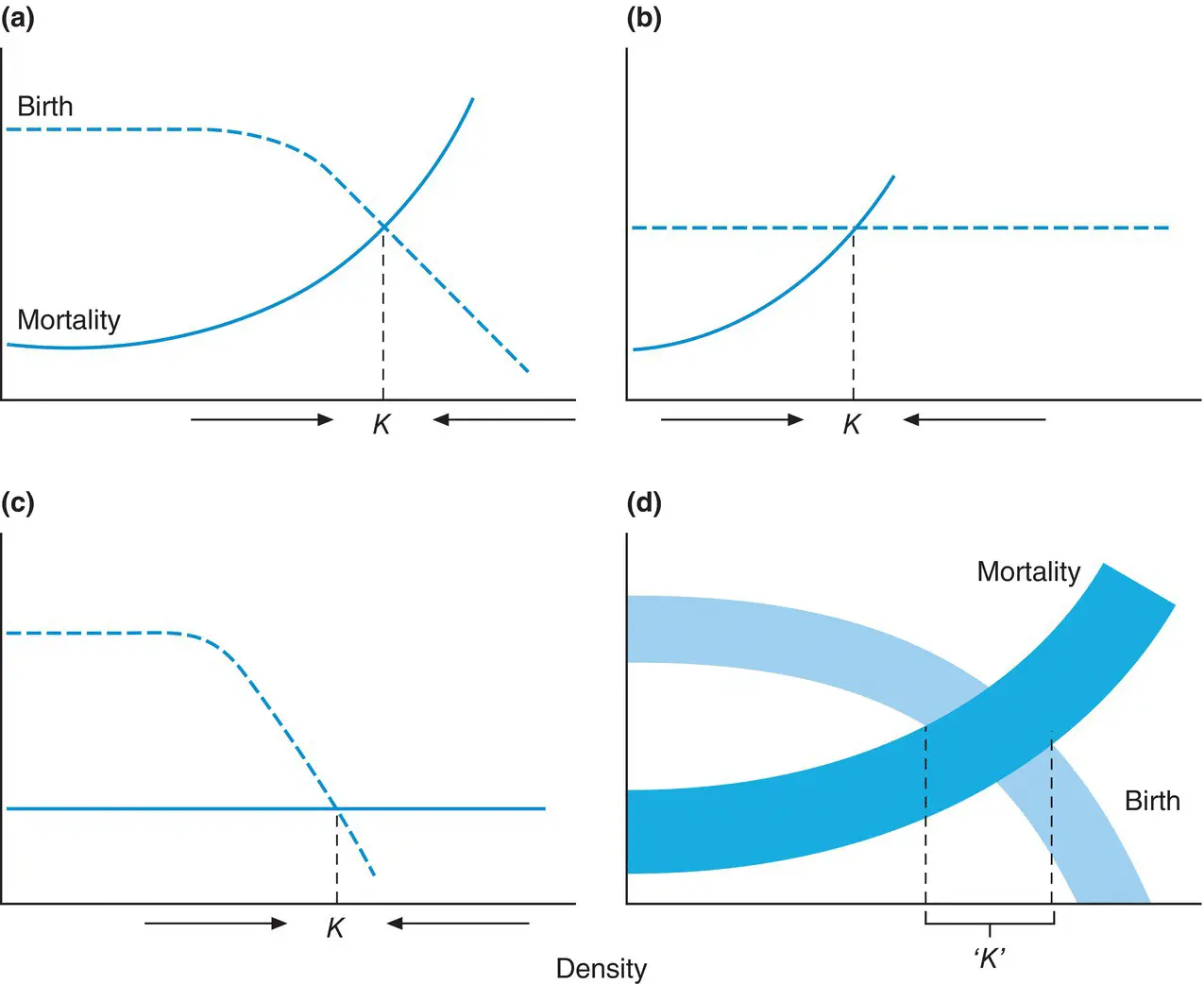
Figure 5.12 Density‐dependent birth and mortality rates lead to the regulation of population size.When both are density dependent (a), or when either of them is (b, c), their two curves cross. The density at which they do so is called the carrying capacity ( K ). Below this the population increases, above it the population decreases: K is a stable equilibrium. However, these figures are caricatures. The situation is closer to that shown in (d), where mortality rate broadly increases, and birth rate broadly decreases, with density. It is possible, therefore, for the two rates to balance not at just one density, but over a broad range of densities, and it is towards this broad range that other densities tend to move.
Читать дальше
